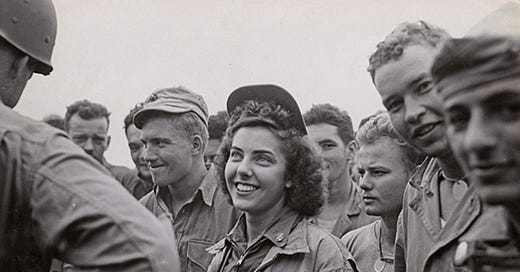TDIH: Jane Kendeigh, flight nurse
The 22-year-old was the first Navy flight nurse to land in an active Pacific combat zone.
On this day in 1945, a flight nurse lands at Okinawa. Jane Louise “Candy” Kendeigh had already made history just one month earlier when she made a similar landing at Iwo Jima.
Kendeigh was the first Navy flight nurse to land in an active Pacific combat zone.
The young nurse had gone through intensive training before she was dispatched to the Pacific. That training was no picnic, covering everything from first aid to the effect of high altitudes on concussions and other wounds. She and other nurses were taught how to fight in hand-to-hand combat on the ground, if needed. They learned how to handle a crash landing in the water.
It wasn’t enough to survive and to know how to swim. Flight nurses had to demonstrate endurance, speed, and the ability to tow a victim for a specified distance.
Kendeigh was then just a 22-year-old woman. A press release would describe her as “108 pounds of green-eyed charm and efficiency,” but she must have been tough. She was among the first of the Navy nurses to finish flight training and travel to the Pacific.
Her actions on March 6, 1945, would go down in history.
Ensign Kendeigh boarded a C-47 in Guam at about 2:00 a.m. that morning. She was headed for Iwo Jima, accompanied by a Navy photographer who’d been tasked with documenting “the first navy nurse in action.”
They arrived at Iwo Jima to discover the airfield under attack. The big plane circled overhead, waiting for a break. “We circled and circled the small island,” Navy photographer Lt. (jg) Gill Dewitt later said, “and watched the bursting shells beneath us like firecrackers on a fourth of July.”
Finally, the plane was able to land, despite the enemy mortar fire. Kendeigh made her way to a field hospital and prepared sixteen wounded for the return flight.
“We took the worst,” she later said. “Others would be evacuated on hospital ships.”
Finally, the plane was back in the air, and the pilot asked Kendeigh if she’d been afraid. “I don’t remember being frightened while we were on the ground,” Kendeigh responded. “There wasn’t time to think about anything except getting these wounded men on board. But now we are safe, in the air again, I find my knees are shaking so I can hardly stand up.”
She did her duty, of course, safely delivering the wounded to Guam—then she undertook the dangerous trip again. Indeed, for two weeks, Kendeigh and her fellow nurses would fly in and out of Iwo Jima, evacuating nearly 2,400 of our boys to relative safety.
Back at home, Kendeigh was a bit of a media sensation. When she left Iwo Jima, she returned to the States and helped a war bond drive. Her heart, however, was with her work back in the Pacific, and she asked to go back. On April 7, she was among the first of the flight nurses to fly into Okinawa.
Kendeigh survived the war and returned home. As so many others in the Greatest Generation would do, she set aside the horrors of what she’d seen and did her best to resume normal life. She couldn’t forget, though, and was proud of her service.
“[O]ur rewards are wan smiles, a slow nod of appreciation, a gesture, a word—accolades greater, more heart-warming than any medal,” she concluded.
Sources can always be found on my website, here.





Jane Kendeigh was the first to rescue wounded men from the battle ground and she paved the way for many others to swiftly medevac wounded to field and general hospitals. Her brave actions saved the lives of many. In later wars, survival chances increased significantly due to prompt evacuation to medical facilities. God bless Jane Kendeigh and all other first responders. Thank you Tara, from an old Navy Corpsman.
Courage under fire comes in many forms. This Nurse, and her colleagues demonstrated what I believe is the greatest form. She put aside fear in favor of serving the soldiers and marines under her care. We've heard her refrain, many times, from our most valorous, "I wasn't scared until it was over."